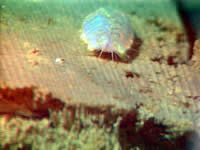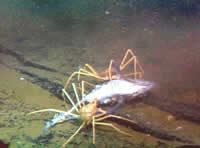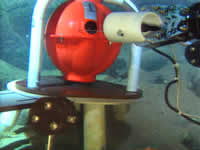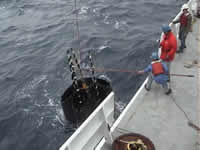| |
Teacher Logbook - NOAA Ship Ron Brown
| |

When the benchmarks were placed on the
bottom, during the summer of 1999, blocks of wood were used to assist
in the deployment. Last year a piece of wood was collected at this
spot (benchmark 2), which was filled with small boring clams. This
year another piece of wood was retrieved at the same spot. All but
a couple of the clams are gone this year, but this scale worm seems
to like the environment. 
Two spider crabs were observed feasting
on a tuna carcass in depths of over 2200 meters.

ROPOS is performing an infrared (IR) reading on an extensometer
at South Cleft. The orange ball houses the computer board that collects
the extensometer data over a one year span. The extensometer is positioned
on a benchmark (the off-white stand with short legs). The IR reader
is the white cylinder that ROPOS is holding. The IR reader downloads
the data from the extensometer using infrared light.

Members of the R/V Ron Brown deck crew retrieve the elevator, which
was
loaded
up with extensometers on the bottom and acoustically released to the
surface.
|
|
Jeff Goodrich's Sealog:
South Cleft Segment of Juan de Fuca Ridge
Imagine living
on an island 274 ft. long and 53 feet wide. You can't leave the island
for weeks at a time. Everything you need (in the short term) food, shelter,
work, play, etc. is supplied on that island. There's no vegetation and
nothing to obstruct your view. For the crew and scientists working on
the ship, this is home.
The R/V RON
BROWN is the newest addition to the NOAA fleet and is one of the nation's
most technologically advanced research ships. It has almost 4,000 square
feet of lab space and in calm seas can use its dynamic positioning system
to keep position within 16 feet. This is important when deploying ROV's
tethered to the ship. The BROWN can hold up to 35 scientists and 24 crew
members. Each of the scientists is assigned a berth (room) that is shared
with one (or two in my case) other people. A bunk-bed, chair, dresser,
and closet are squeezed into the tiny room. Two berths share a head (bathroom).
Most of the crew and scientists sleep below the main deck so there are
no windows. All night (and day) you can hear the bow thrusters rotating
continually to keep the ship in place. Ear plugs are a must. The three-person
cooking staff supplies three meals per day. Breakfast is from 7 -8, lunch
from 11-12 and dinner from 4:30-5:30. Since there are 59 people on board
and the galley (dining area) can't hold everyone at once, the crew and
ROPOS team eats during the first half-hour and the scientists eat during
the second half-hour. A sign hangs in the gally. "Eat it and beat it."
Since the ship runs 24 hours a day and some people are on watches in the
middle of the night,
A refrigerator
is stocked with food those who miss meals. The galley is usually crowded
during meal times, filled with discussions of the next dive, old cruise
stories and laughter.
When not
working or on a watch there is occasionally some free time. In the< evening
two of the 800 or so movies on board are shown in the lounge. People gather
and watch the large TV with surround sound. Between the two movies the
ship's store occasionally opens for about 15 minutes selling t-shirts,
hats, bathroom supplies and snacks. Other entertainment options include
a large pin-pong table that's kept in the main science lab next to Dave
Butterfields vent fluid sampler. There are often people practicing for
the upcoming tournament. Below the hydro lab in the science store room
is the ship's< mini-gym. A treadmill, rowing maching, bike and various
weights help keep the ice cream cravings under control . Working out also
feels great when there's nowhere to go. The only thing I've been hesitant
about is jump-roping. With the swells, I'd probably end up in a knot.
|
|

